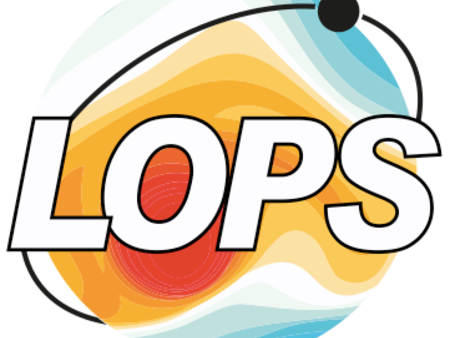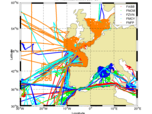French REsearch SHips
French Research vessels have been collecting thermo-salinometer (TSG) data since 1999 in the framework of 'Coriolis/Mesures Navires'. The instruments are regularly calibrated and continuously monitored. Water samples are taken on a daily basis by the crew and later analysed in the
laboratory. We present here the processing that lead to the annual update of the salinity dataset, in contribution to the Global Ocean Surface Underway Data (GOSUD) programme.
Ocean salinity is a key parameter of the freshwater cycle of the earth system. It influences the ocean
circulation by acting on the density field and is also used as a tracer of water mass origin. Ocean salinity
is one of the Essential Climate Variables (ECVs) identified by the Global Climate Observing System
(GCOS). The requirements for observing the near-surface are for higher time and space sampling because this
ayer interacts with the atmosphere, the ocean-land boundary and the ice, inducing fronts and small scale
structures that can be very intense and rapidly changing. The challenge of monitoring surface salinity
at global scale has become a step closer with the launch of two satellites: SMOS (Europe) in November
2009 followed by Aquarius (US/Argentina) in June 2011.
Ships equipped with thermo-salinometers provide high resolution measurements along their track.
These devices measure the conductivity and temperature of the water pumped in through the ship's
seawater intake to deduce salinity. The nominal instrumental accuracy of the measurement is better than
0.01 PSS and the resolution close to 0.001 PSS, which is largely sufficient to capture the surface variability.
However, siting of the instrument, stability of the electronics, sufficient flow through the conductivity cell,
air bubbles and contamination by fouling and deposits may dramatically increase the measurement errors
and even lead to discarding the data.
The Global Ocean Surface Underway Data programme (GOSUD) of the Joint Technical Commission
for Oceanography and Marine Meteorology (JCOMM) and the International Oceanographic Data and
Information Exchange (IODE) began in the early 2000’s with the main objective of developing the ocean
surface measurements and assembling qualified datasets.
The continuous data acquisition of thermosalinometer data on board French Research Vessels was initiated in 1999. To ensure a data quality inaccordance with current research standards, a methodology was developed, following what was done for the data collected on board merchant ships by the Sea Surface Salinity Observation Service (SO-SSS).
The procedure described here has been designed for the research vessels by a group of French research
institutes (Ifremer, IRD, INSU, SHOM).
To facilitate the maintenance of the equipment, a set of similar instruments has been selected: the
SBE-21 device provides the salinity value and an additional temperature sensor is installed in the water
inlet (generally a SBE-3S or SBE-38 sensor) to obtain the ocean temperature, that may differ from the
temperature of the water when it reaches the conductivity cell inside the ship. The sensors are calibrated
annually by the SHOM metrology service and returned to Seabird Electronics when non-conformities are
detected, otherwise an offset and a slope are estimated and taken into account in the instrument software.
On board ships operated by Ifremer/Genavir (at the present time all ships except the Beautemps-
Beaupré), the installation and the operation of the instruments is performed by the crew. A similar system
is applied on the ship operated by other partners. Instruments are cleaned at the beginning of each cruise
and water samples are taken on a daily basis and later analysed in the SHOM laboratory. Reduced data
are transmitted in real time to the Coriolis datacentre and full resolution data are archived on board and
provided to the SISMER/Ifremer datacentre after the cruises. When the samples for a full year have been
analysed, the delayed mode processing is performed. This includes a visual quality control of temperature
and salinity, and the estimation of a correction to produce the corresponding ‘adjusted’ variable. At the
end of the processing the dataset is uploaded into the GOSUD database.






